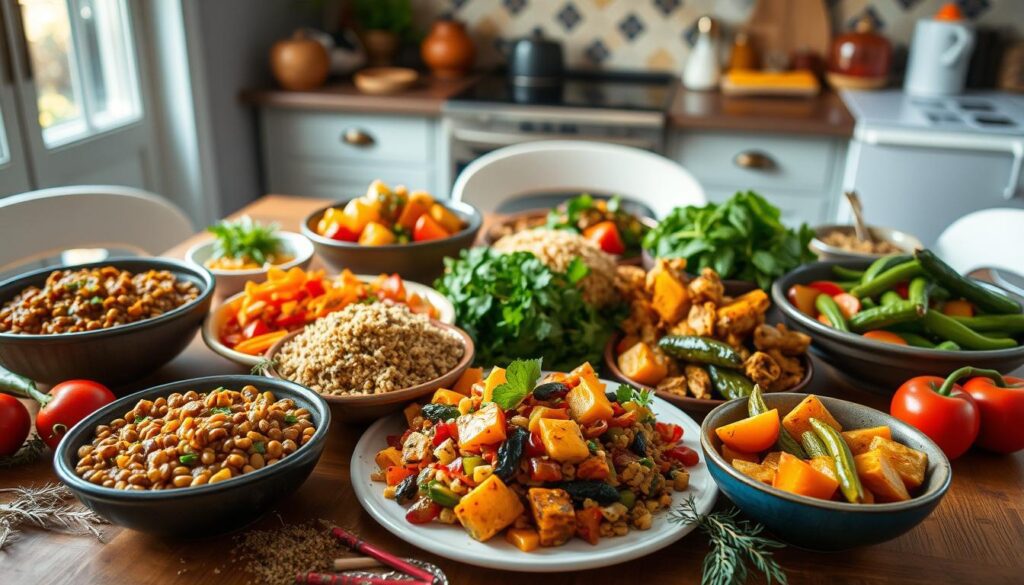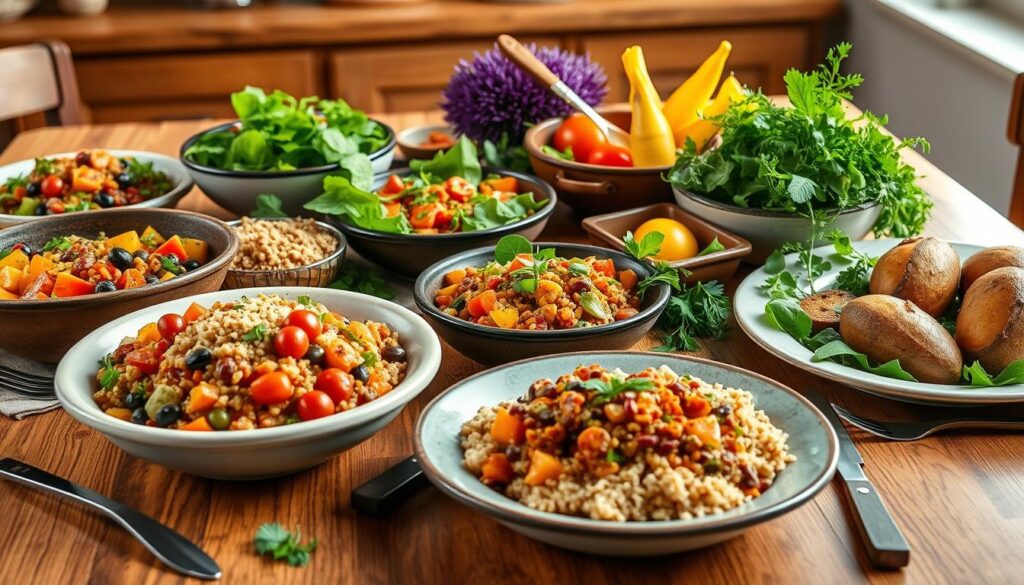As an Adventist, your dinner table shows your commitment to health. It’s based on biblical values and a love for nutritious foods. Your meals are filled with plant-based goodness, from legumes to meat substitutes. This mix of ingredients makes your dinner both healthy and enjoyable.

In this guide, we’ll dive into the Adventist diet’s main ideas. We’ll look at delicious dinner options that showcase this healthy tradition. Plus, we’ll share tips for making Adventist meals that are tasty and good for you. Get ready to explore a world of Adventist flavors and wellness.
Understanding Adventist Dietary Principles
The Adventist diet is based on biblical teachings and a focus on total health. It views the body as a temple, encouraging careful food choices. This approach helps Adventists make better decisions about what they eat.
Biblical Foundation of Adventist Diet
The Adventist diet starts with the book of Genesis. It teaches to eat from every tree in the garden (Genesis 2:16). This leads to a diet rich in adventist cuisine and meat-free dishes, focusing on natural, unprocessed foods.
Health Message and Nutrition Guidelines
Adventists see caring for their bodies as a spiritual act. They follow a diet full of nutrients, including fresh fruits, veggies, whole grains, and legumes. They limit processed foods, sugars, and unhealthy fats.
Modern Interpretation of Dietary Laws
Adventists have updated their diet based on new research. They keep some traditional rules but also value balance and moderation. This approach makes their adventist cuisine and meat-free dishes healthier and more balanced.

What Do Adventists Eat for Dinner?
Adventists follow a plant-based diet, focusing on health. Their dinners are filled with what do adventists eat for dinner? They enjoy hearty, flavorful dishes made from plants. These meals come with nutrient-rich sides and sweet desserts.
At the heart of Adventist dinners are adventist cooking like lentil or bean casseroles. They also have savory vegetable stews and meatless stir-fries. These dishes are rich in protein and packed with fresh produce, whole grains, and spices.
| Adventist Dinner Staples | Description |
|---|---|
| Lentil and Bean Dishes | Hearty, protein-packed stews, casseroles, and curries featuring a variety of legumes. |
| Vegetable Stir-Fries | Colorful, flavorful dishes featuring a mix of fresh, seasonal vegetables. |
| Whole Grain Sides | Nutrient-dense options like brown rice, quinoa, and whole wheat bread or rolls. |
| Roasted Vegetables | A variety of roasted root vegetables, leafy greens, and other produce. |
| Wholesome Desserts | Fruit-based pies, plant-based ice creams, and other sweet treats. |
The Adventist dinner plate aims for balance and nutrition. It focuses on plant-based, whole foods. This way, Adventists honor their health and wellness goals through their meals.

Plant-Based Protein Sources in Adventist Meals
Adventists eat a diet rich in plant-based foods. They use legumes, nuts, seeds, and meat alternatives for protein. These foods are key in Adventist kitchens.
Legumes and Pulses
Legumes like lentils, beans, and peas are vital in Adventist meals. They’re packed with protein and are great in soups and main dishes. Pulses, including dried beans and chickpeas, add fiber and minerals, making dishes creamy.
Nuts and Seeds
Adventists also enjoy nuts and seeds for dinner. Almonds, walnuts, sunflower seeds, and pumpkin seeds are used in many ways. They’re good for salads, sauces, and as bases for meat alternatives. These foods are rich in healthy fats and minerals.
Meat Alternatives
Adventists have many plant-based protein options that taste like meat. Soy products like tofu and tempeh are popular. Mushroom-based “meats” and nut-based patties are also favorites. They’re great in burgers, meatballs, stir-fries, and casseroles.
| Plant-Based Protein Source | Nutritional Benefits | Adventist Dinner Applications |
|---|---|---|
| Legumes (Lentils, Beans, Peas) | High in protein, fiber, and essential minerals | Soups, stews, casseroles, main dishes |
| Nuts and Seeds | Rich in healthy fats, protein, and antioxidants | Salad toppings, sauces, meat alternatives |
| Meat Alternatives (Tofu, Tempeh, Seitan) | Provide protein, texture, and versatility | Burgers, meatballs, stir-fries, casseroles |
Essential Components of an Adventist Dinner Plate
Your Adventist dinner plate should be a work of art in nutrition. It should include whole grains, lots of fresh veggies, juicy fruits, and plant-based proteins. This mix is key to a healthy Adventist meal, following the adventist diet and vegetarian recipes lifestyle.
Begin with whole grains like brown rice, quinoa, or whole wheat bread. These foods are full of fiber, giving you lasting energy and important nutrients. Then, fill your plate with colorful veggies, from leafy greens to vibrant roots. This way, you get a wide range of vitamins, minerals, and antioxidants.
Add plant-based proteins like legumes, nuts, or soy-based meats to your meal. These proteins work well with the other foods, making a balanced, healthy dinner. Finish with fresh fruit for a sweet touch and more nutrients.
By using these key ingredients, you can make an Adventist dinner that tastes great and is good for you. Try different whole, plant-based foods to find tasty Adventist meals.
Popular Adventist Dinner Recipes
Adventists are known for their tasty and healthy food. They love making dishes with plants. Adventist dinners are full of creativity and skill. Let’s look at some favorite Adventist dinner recipes you can make at home.
Main Course Options
Adventist meals often have big, protein-rich dishes. They use meat alternatives like lentil loaves or soy burgers. These dishes are both tasty and good for you.
They also make lots of vegetable casseroles, stews, and curries. These dishes are comforting and full of nutrients.
Side Dish Favorites
Adventist dinners come with many tasty side dishes. They make vegetarian recipes like roasted root veggies, sautéed greens, and creamy mashed potatoes. These sides make the meal look good and are good for you too.
Wholesome Desserts
Adventist dinners always have a sweet treat. They prefer vegetarian recipes with natural ingredients like fresh fruit, nuts, and whole grains. You can find vegan cakes and creamy puddings that are sweet but not bad for you.
Adventist food shows how great plant-based cooking can be. By trying these recipes, you’ll find lots of tasty and healthy dishes. They will make your meals exciting and good for your health.
Meal Planning Tips for Adventist Families
As an Adventist, making plant-based meals can be rewarding but also challenging. Here are some easy adventist cooking tips to help plan meals for your family.
Batch cooking is a great strategy. It means making big batches of foods like legumes, grains, and veggies. This saves time and ensures your meals are healthy and varied. Also, prep ingredients or sauces ahead to make cooking easier every day.
When planning your meals, aim for a mix of proteins, carbs, and lots of veggies. This follows Adventist dietary rules and keeps your family healthy.
Set aside one day for meal planning and shopping. This helps you plan better and avoid last-minute trips. It lets you think about your family’s needs and any upcoming events.
Using these adventist cooking tips, you can make meal planning easier. You’ll save time and enjoy tasty, plant-based meals that are good for your health and spirit.
Seasonal Variations in Adventist Dinner Choices
As seasons change, Adventist dinners adapt to use fresh, local produce. They offer light spring and summer dishes and hearty fall and winter meals. Adventist families adjust their adventist diet and vegetarian recipes to enjoy seasonal ingredients.
Spring and Summer Meals
With warmer weather, Adventist dinners feature plant-based dishes. Fresh fruits and vegetables are the stars, making salads, vegetable entrees, and grain bowls popular. Adventists use seasonal produce like leafy greens, tomatoes, and berries for light, energizing meals.
Fall and Winter Comfort Foods
In cooler weather, Adventist families enjoy heartier meals. Soups, stews, and casseroles with root vegetables and grains are common. They also make seasonal treats like pumpkin or apple pies, staying true to their adventist diet and vegetarian recipes.
Adventist dinners reflect a love for the earth and sustainable living. They enjoy both light summer meals and warm winter dishes. This way, they nourish their bodies and souls all year.
Nutritional Benefits of Adventist Dinner Choices
As an Adventist, you know the value of a balanced, plant-based diet. Adventist dinners are not just tasty but also full of nutrients. These meals offer many health benefits.
Adventist dinners often have plant-based proteins like legumes, nuts, and soy-based meats. These are low in bad fats and cholesterol but high in fiber, vitamins, and minerals. Eating this way can help your heart, digestion, and weight.
Adventist meals also include lots of fresh veggies and fruits. These foods are full of antioxidants, vitamins, and minerals. They boost your immune system, skin health, and lower disease risks like cancer and diabetes. The fiber in these foods helps control blood sugar and digestion.
Whole grains like brown rice, quinoa, and whole wheat are common in Adventist dinners. They give you lasting energy, support your brain, and improve overall health. They’re also packed with B vitamins, key for turning food into energy.
By following the adventist diet and eating plant-based meals, you get many health benefits. From heart health to immune function, Adventist dinners are a tasty, nutritious way to nourish your body.
Shopping Guide for Adventist Dinner Ingredients
Starting to cook Adventist-style dinners at home is easy with the right ingredients. Whether you’re experienced or new, this guide will help you shop. You’ll learn about pantry staples, fresh produce, and specialty items to make your Adventist meals better.
Pantry Essentials
First, stock your pantry with key ingredients for Adventist meals. Get wholesome grains like brown rice, quinoa, and whole-wheat pasta. Legumes, such as lentils, chickpeas, and black beans, are great for protein.
Nuts and seeds, like almonds, walnuts, and chia seeds, are full of healthy fats and nutrients. Spices like cumin, turmeric, and oregano add flavor to your dishes.
Fresh Produce Selection
Adventist diets focus on fresh, seasonal veggies and fruits. Fill your cart with leafy greens like kale, spinach, and Swiss chard. Also, pick colorful produce like bell peppers, carrots, and broccoli.
Include fresh herbs like basil, cilantro, and parsley to boost flavors. Remember to add onions, garlic, and potatoes to your list.
Specialty Items
Check out the special aisles for unique ingredients to enhance your Adventist cooking. Look for plant-based milk alternatives and nutritional yeast for a cheesy taste. Use high-quality olive oil and balsamic vinegar for dressings and marinades.
Find meat alternatives like tofu, tempeh, and seitan to add protein to your meals.
FAQ
What are the typical dinner options for Adventists?
Adventists often have dinner with a focus on plant-based foods. They enjoy dishes made from grains, legumes, and vegetables. They also have fruits and meat alternatives.
What are the fundamental principles of the Adventist diet?
The Adventist diet is based on biblical teachings and health. It’s a plant-based diet with a focus on whole foods. They also eat animal products in moderation.
How do Adventists incorporate plant-based proteins into their meals?
Adventists use many plant-based proteins like legumes and nuts. They also use seeds and meat alternatives. This makes their meals balanced and nutritious.
What are the essential components of a typical Adventist dinner plate?
An Adventist dinner plate has whole grains and lots of vegetables. It also includes fruits and plant-based proteins. This mix provides a healthy and filling meal.
Can you provide examples of popular Adventist dinner recipes?
Adventists love recipes like vegetable stews and lentil curries. They also enjoy quinoa bowls and plant-based “meats.” Plus, they have tasty side dishes and desserts.
How do Adventists adapt their dinner choices to different seasons?
Adventists change their dinner menus with the seasons. In spring and summer, they eat lighter meals. In fall and winter, they prefer heartier dishes.
What are the key nutritional benefits of the Adventist dinner choices?
Adventist dinners are packed with nutrients and fiber. They are rich in antioxidants, vitamins, and minerals. This supports their health and well-being.
How can Adventists stock their pantries and refrigerators for dinner preparation?
Adventists stock up on whole grains, legumes, and fresh produce. They also have nuts, seeds, and meat alternatives. This helps them make their plant-based dinners.

